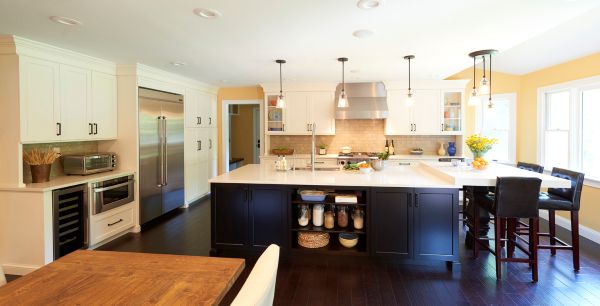Open-concept floor plans used to be the default go-to layout, but they have been declining in popularity in recent years. They might not be dead, but their popularity is shifting from being the most popular to being one choice among many. Homeowners have expressed an increasing desire for flexible spaces and privacy for work-from-home lifestyles.
While open-concept layouts offer benefits like a sense of spaciousness, lots of natural light and space for family togetherness, the demand for closed-concept layouts with well-defined, private rooms has grown since the pandemic.
The future most likely involves a combination of both closed and open layouts, with homes featuring flexible private spaces alongside open areas for family and entertaining.
Before recommending your clients knock down walls, let’s look at the pros and cons of an open-concept floor plan.
Why Open-Concept Floor Plans Remain Popular
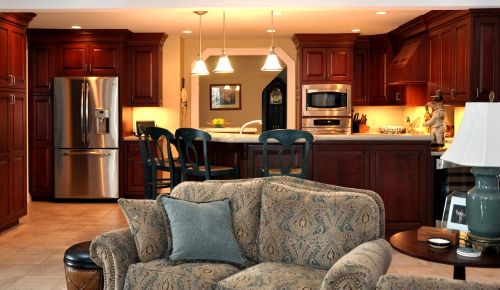
- Flexibility. With fewer walls, people can move their furniture however and wherever they want.
- Spaciousness. Without walls, smaller spaces feel larger
- Natural Light. When there are no walls, light can stream through windows throughout the living area. People are looking for a greater connection with nature, and natural light is a top request.
- Family Connection: It’s easy to supervise children and prepare meals while interacting with family and guests.
- Modern Living: Open-concept floor plans create a casual, less formal atmosphere.
- Freedom of Movement: Homeowners can personalize the traffic flow between the different areas.
Why Homeowners are Moving Towards Closed-Concept Floor Plans
- Need for Privacy: Working from home has created the demand for quiet spaces where people can work without distractions. A home office with a door provides that space which is impossible in an open-concept home.
- Odor Control: Separate kitchens are better for containing cooking smells. Cooking smells linger, especially in winter when ventilation is limited. Cooked bacon for breakfast? Everyone will know.
- Escape the Noise. Sound travels, and in open spaces, it travels farther because there’s nothing to stop it. Someone watching TV? Then everyone has to hear it. Further, kitchen noise from rangehoods, dishwashers, blenders, etc., carries into the living area.
- Lower Utility Bills. Open spaces are harder to heat and cool efficiently. Doors can be closed to maintain temperatures in specific areas. As energy prices rise, homeowners are prioritizing energy efficiency.
- Reduce Visual Clutter. There’s nowhere to hide the mess in an open-concept layout. If the kitchen is untidy, everyone sees it. If the kids leave their toys everywhere, there’s no way to contain the chaos. Individual rooms allow homeowners to close a door and keep certain areas out of sight.
Compromise: The Future is Hybrid
Talented designers have tweaked the all-or-nothing approach to open layouts. The broken floor plan is a hybrid of connection and definition. It maintains sightlines and flow while introducing subtle boundaries that give each zone its own purpose. It’s a flexible design strategy that supports today’s multifunctional kitchens and the way people actually live.
The Broken Floor Plan
The broken floor plan layout keeps the benefits of open-concept layouts. However, it creates separate functional areas for better privacy. It helps divide up the living space without completely closing it off to other areas. It offers a good blend of connection and separation. It’s a happy medium for people who think an open floor plan is overrated, but a closed floor plan is too limiting.
A broken floor plan has some kind of architectural feature or design element that makes it more sectioned off than an open-concept floor plan.
Some of the features and design elements that can be used to create a broken floor plan layout include:
- glass partitions
- half walls
- free standing furniture arrangements
- built-in shelving
- fireplace
- seating areas
- wall treatments
- central storage unit
- partial walls
- glass partitions (especially desirable because they add privacy without blocking light)
- sliding doors
- a classic kitchen layout — galley-style, U-shaped, L-shaped
- decorative screens
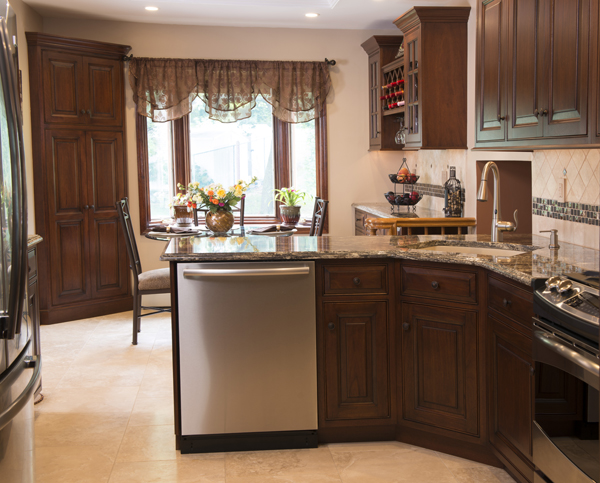
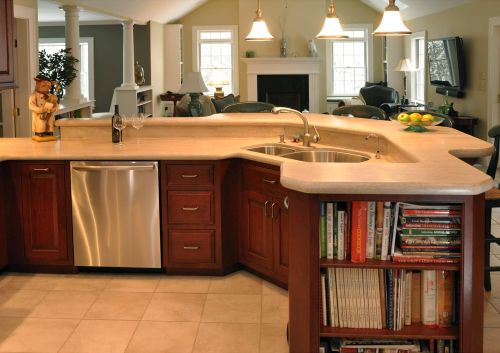
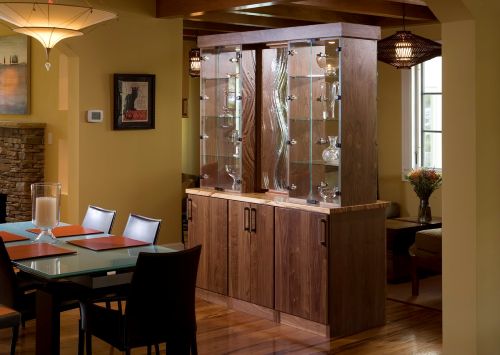
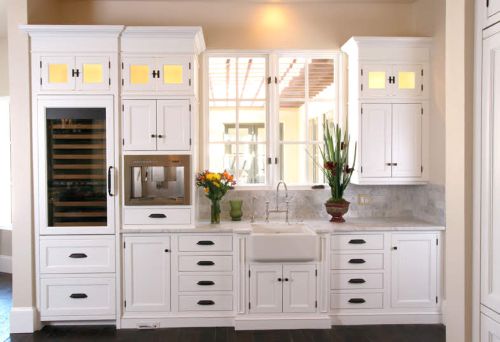
Invisible Kitchen
If your client likes an open-concept floor plan, but she doesn’t like to look at kitchen elements while sitting in her living room, an existing kitchen can be modified by designing an “invisible kitchen”. An invisible kitchen can be created by camouflaging range hoods, refrigerators, sink cabinets and dishwashers behind cabinetry doors and panels or beneath countertops to the point that the kitchen becomes “invisible” when not in use.
To achieve the “invisible” or concealed look:
- Use the same colors, materials and finishes in both the kitchen and the adjacent living area.
- Specify matching panels for refrigerators, dishwashers and range hoods.
- Omit cabinet hardware for a smooth, uninterrupted run of base and/or wall cabinets
- Extend cabinets to the ceiling <or>
- Eliminate wall cabinets altogether
- Utilize under-counter space for drawers and storage
- Use counter-height appliances
- Remove items that draw attention to countertops, islands and other surfaces, including appliances like toasters, coffee makers and blenders, or dinnerware and mugs
- Choose a backsplash that will blend into the rest of the space. A colorful one might be beautiful, but it won’t work for an “invisible” kitchen.
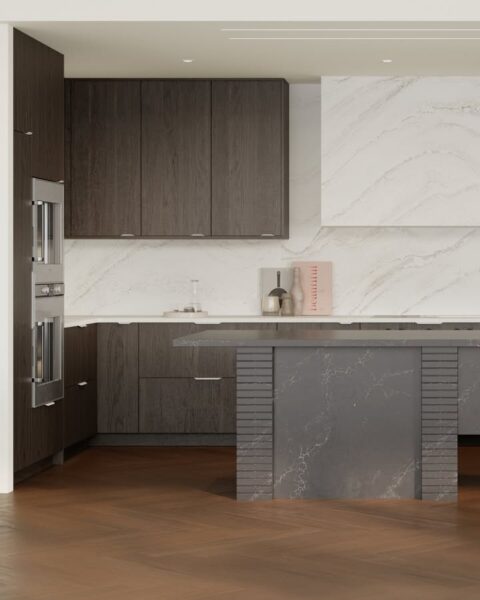
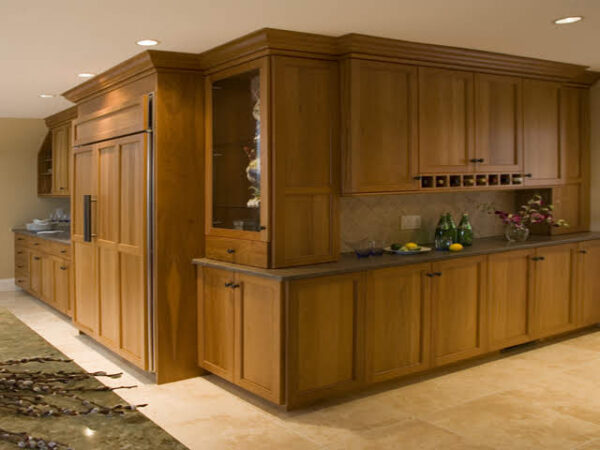
Open-Concept Floor Plan or Not?
In the end, the choice between separate rooms, open-concept layouts, or a hybrid combination comes down to how homeowners live day-to-day. Today’s clients are less concerned with trends and more focused on creating homes that support their lifestyle.
Open-concept spaces once defined modern living, blending kitchen, dining, and family areas to encourage connection. But as needs evolve, so do priorities—noise, clutter, and lack of privacy have many people rethinking the value of defined spaces. The demand for comfort, practicality, and quiet is reshaping how we approach design.
As a kitchen designer, your role is to help clients find that balance—spaces that are as functional as they are beautiful, and that reflect the way they truly live.
Bob Aungst Cabinet Sales is a full-service rep agency with the goal of matching kitchen designers and remodelers with the cabinet manufacturers best suited to their business’ style and clientele. Owner Bob Aungst III represents Brighton Cabinetry, US Cabinet Depot, Integrity Cabinets and StyleCraft Luxury Custom Cabinets.

